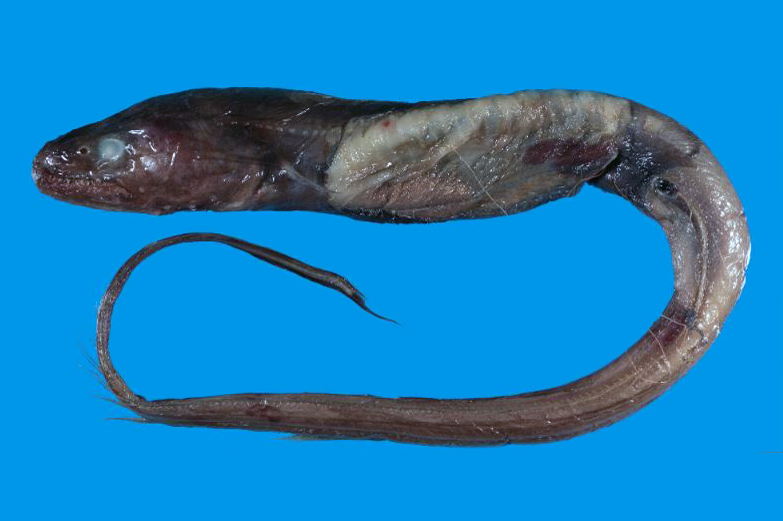- Classification
- ACTINOPTERYGII
- ANGUILLIFORMES
- CONGRIDAE
- Bathyuroconger
- parvibranchialis
Small-gill Large-toothed Conger, Bathyuroconger parvibranchialis (Fowler 1934)

A Small-gill Large-toothed Conger, Bathyuroconger parvibranchialis (ASIZP 63789), from off Dong-gang, Taiwan, South China Sea, August 2002, depth 507 m. Source: After Fig. 9C, in Smith et al. (2018) 4454(1): 147–167 / and Fish Database of Taiwan. License: CC by Attribution-NonCommercial-ShareAlike
Summary:
A conger eel with adults having a uniformly blackish body. Juveniles are pale with rows of small melanophores. The species has a very small gill opening.
Cite this page as:
Bray, D.J. 2024, Bathyuroconger parvibranchialis in Fishes of Australia, accessed 30 Jun 2025, https://fishesofaustralia.net.au/Home/species/5737
Small-gill Large-toothed Conger, Bathyuroconger parvibranchialis (Fowler 1934)
More Info
|
Distribution |
Off Western Australia, from SW of Rowley Shoals to SW of Point Cloates. Elsewhere the species occurs in the Western Pacific: Indonesia east to the Philippines, north to China, Taiwan, Korea and Japan. Inhabits soft sediment areas on the continental slope. |
|
Features |
Vertebrae - preanal 43-48, precaudal 52-60, total vertebrae 181-189. Gill opening very small, its width 1.8–9.0% of head length; gill opening separated from pectoral fin base by a greater distance than its width; head length 1.4–1.7 times in trunk length, 35.2–40.9 %PAL; predorsal length 12.6–14.5 %PAL, trunk length 59.1–64.8 %PAL. Preanal lateral-line pores 39–47. MVF 9–46–185. |
|
Etymology |
The specific name parvibrachialis is from the Latin parvus (= little) and branchialis (= gills), in reference to the "very small gill opening, with the appearance of a large pore with a slightly elevated cutaneous rim.” |
|
Species Citation |
Silvesterina parvibranchialis Fowler 1934, Proceedings of the Academy of Natural Sciences of Philadelphia 85: 275, Fig. 35. Type locality: Butung [Buton] Strait, Philippines, 5°35'00"S, 122°20'00"E, Albatross station 5648, depth 559 fathoms. |
|
Author |
Bray, D.J. 2024 |
|
Resources |
Small-gill Large-toothed Conger, Bathyuroconger parvibranchialis (Fowler 1934)
References
Fowler, H.W. 1934. Descriptions of new fishes obtained 1907 to 1910, chiefly in the Philippine Islands and adjacent seas. Proceedings of the Academy of Natural Sciences of Philadelphia 85: 233-367. https://www.jstor.org/stable/4064176
McCosker, J., Smith, D.G. & Tighe, K. 2019. Bathyuroconger parvibranchialis. The IUCN Red List of Threatened Species 2019: e.T199016A2550183. https://dx.doi.org/10.2305/IUCN.UK.2019-1.RLTS.T199016A2550183.en. Accessed on 14 October 2024.
Smith, D.G. 1999. Families Colocongridae, Derichthyidae, Muraenesocidae, Nemichtyhyidae, Congridae, Nettastomatidae, Serrivomeridae, Cyematidae, Saccopharyngidae, Eurypharyngidae, Monognathidae. pp. 1670-1697 in Carpenter, K.E. & Niem, V.H. (eds). The Living Marine Resources of the Western Central Pacific. FAO Species Identification Guide for Fisheries Purposes. Rome : FAO Vol. 3 pp. 1397-2068.
Smith, D.G., Ho, H.-C. & Tashiro, F. 2018. Eels of the genus Bathyuroconger in the northwestern Pacific, with descriptions of four new species (Anguilliformes: Congridae). Zootaxa 4454(1): 147-167. https://doi.org/10.11646/zootaxa.4454.1.13

